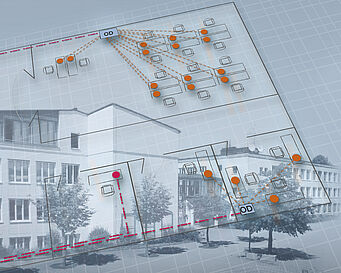Cabling specialist drives school digitization forward, relying on state-of-the-art tools and methods for planning
Augsburg, April 5, 2022 – Rosenberger Optical Solutions & Infrastructure (Rosenberger OSI), an expert in fiber optic connections, cabling solutions and infrastructure services, has established itself as a competent partner in the digitization of schools with its holistic approach as part of the “DigitalPakt Schule” in Germany. The specialist uses state-of-the-art methods and tools, such as Building Information Modeling (BIM), for planning and project management. “We have already successfully accompanied a number of schools on their way to digital classrooms. In doing so, we rely on a holistic approach. This includes the initial inventory and target definition, planning as well as construction support,” says Managing Director Thomas Schmidt.
In order to promote digitization in general education schools, the federal and state governments in Germany adopted the “DigitalPakt Schule” funding program in 2019. The aim is to establish a comprehensive and up-to-date digital education infrastructure. A total of 6.5 billion euros in funding will be made available for this purpose until 2025. For many educational institutions, however, implementation is proving difficult because it requires not only the acquisition of new computer units but also holistic concepts. For this, support from IT and cabling experts is indispensable. “The additional bandwidth requirements of a digitized school and the necessary upgrading of electrical cabling should not be underestimated. Digital teaching and learning can only function smoothly with a needs-based IT infrastructure,” says Martin Lukas, Process Manager Services at Rosenberger OSI.
Modern IT infrastructure at schools in three phases
Rosenberger OSI has addressed this issue and developed a holistic concept for the upcoming digitization projects of general education schools, which will be accompanied by the cabling experts throughout each phase of implementation. Rosenberger OSI defined three phases for this purpose: In the first phase, the inventory and target definition is carried out. For this purpose, among other things, the current IT infrastructure is evaluated and the current digital level is defined. Phase two is followed by the planning of the future IT infrastructure and the preparation of a time and cost plan. Phase two also includes the preparation of the invitation to tender, the bid review, and support in the actual procurement. The final phase three defines the construction support and coordinates the subsections during the installation of the electrical and data technology and ensures project monitoring and documentation. For this holistic approach, a partnership was formed with BACC GmbH & Co. KG, which also focuses on the digitization of schools and specializes, among other things, in professional WLAN illumination.
Planning according to HOAI and BIM
Rosenberger OSI provides all planning services in accordance with the german HOAI (Fee Structure for Architects and Engineers). This regulates the remuneration for services in the construction industry in Germany, among others, and is therefore also the basis for the revitalization of IT infrastructures within school digitization projects. The aim of this regulation is, on the one hand, to avoid a price war and, on the other hand, to ensure the quality of planning, tendering, awarding and construction supervision.
Furthermore, the cabling expert rely on state-of-the-art tools such as BIM (Building Information Modeling). With this holistic method, building models can be digitally mapped with all relevant information in great detail throughout the entire planning and installation process. The shared database and 3D visualization create a better understanding of the project between all parties involved. “This not only increases efficiency in the planning of construction projects, but also quality, schedule and cost compliance,” explains Martin Lukas.


